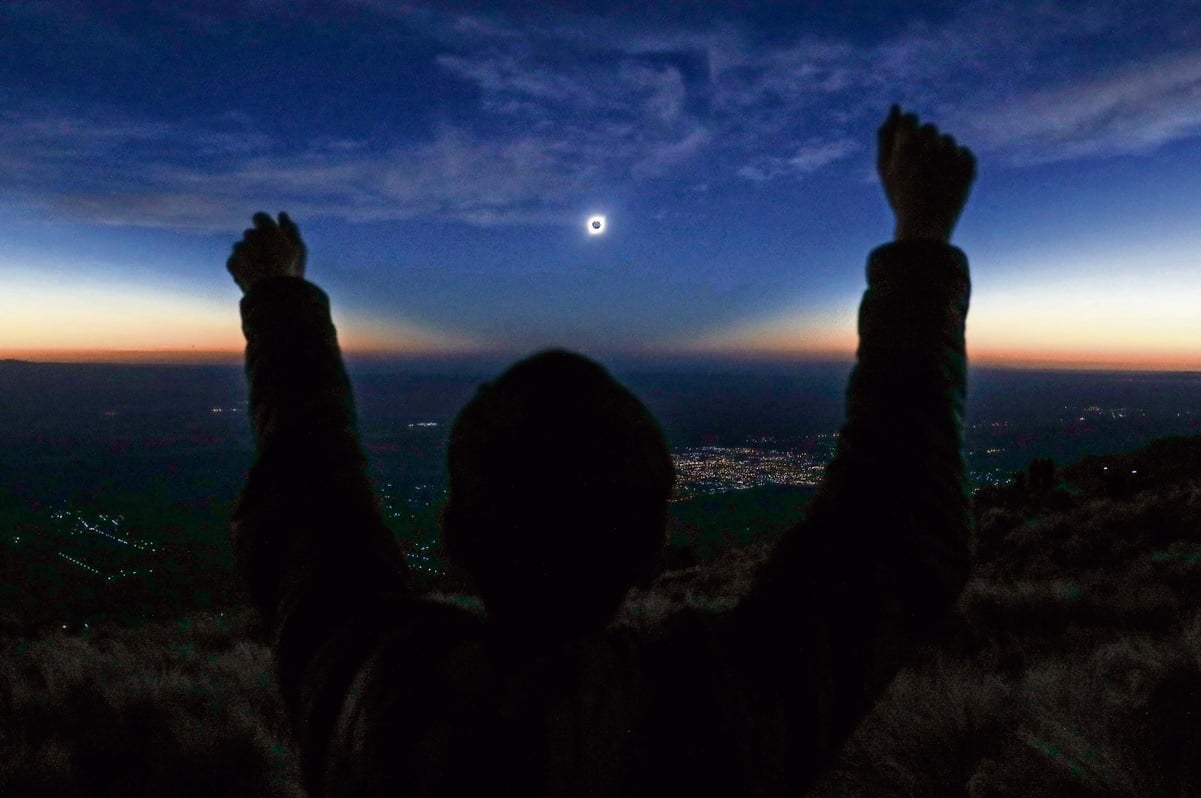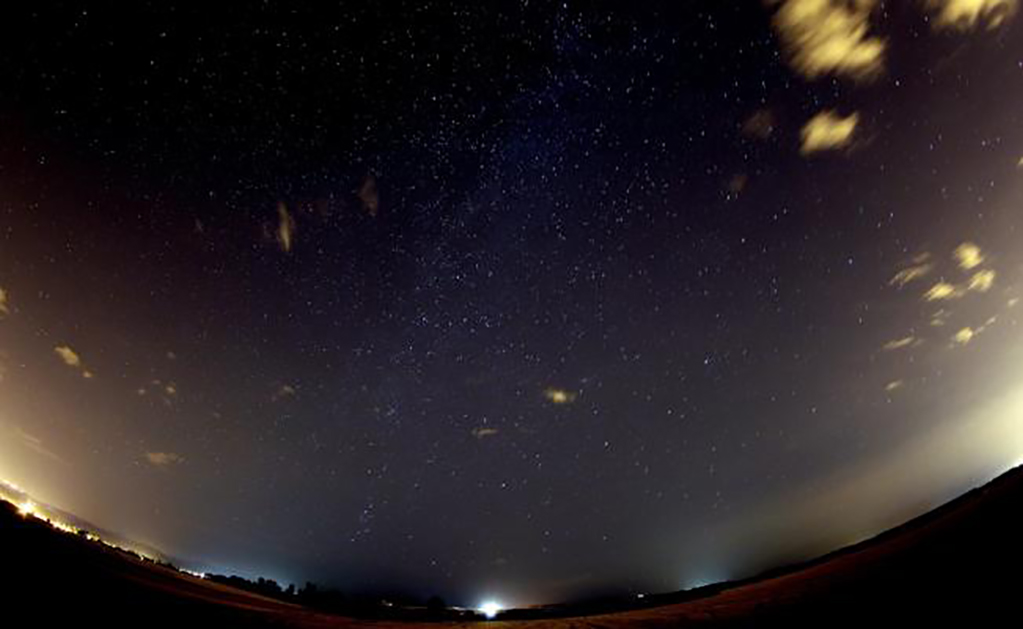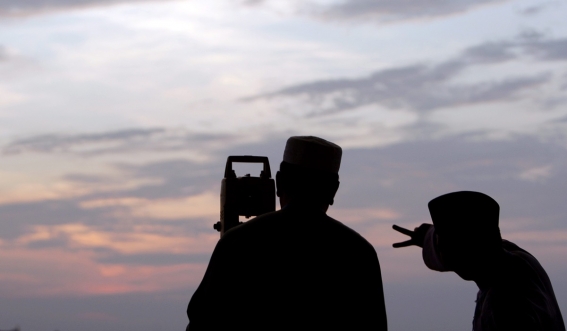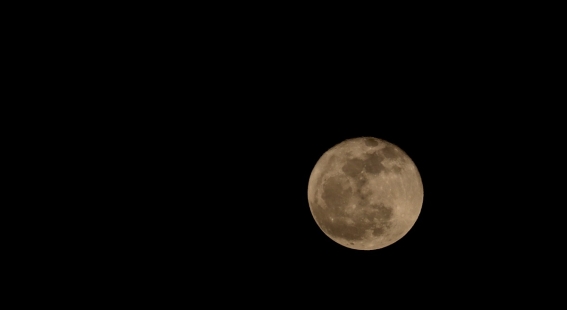In December, the last month of the year, as if to celebrate the end of a cycle, innumerable astronomical events occur, than those that occur regularly. A few days before the end of 2021, the sky will be filled with various phenomena, among them: a total solar eclipse, the sighting of Leonard’s Comet (the brightest of the season), two meteor showers, as well as the meeting of “floating stars” that will delight us with their approach in the sky. Not enough, we will also see a change of season, as autumn will abandon us and bring on the coming of winter. When and what is the ideal time to see them?
December 3rd: conjunction of the Moon and Mars
It is known as a “planetary conjunction” when two or more astronomical objects appear to be located very close to the sky – since they are actually millions of kilometers away from each other – to be viewed from Earth. According to “Royal Museums Greenwich”, to determine this phenomenon, astronomers use the “elliptical coordinate system”. To calculate that the position, in this case, for Luna And Mars, being an oval, experts measure the longitude and latitude dividing or approximating both: if they are on the right ascending, or on the same line slightly inclined, they are considered interconnected.
The proximity between Mars and the natural moon would be 0.4 degrees toward lunar north. The best time to appreciate their meeting in heaven would be at 6:28 p.m. in Mexico City. Of the two, the Red Planet will be the easiest to detect by a terrestrial viewer, as it will have a magnitude (luminosity) of 1.6, while the Moon will be -8.9 bright, plus the moon’s phase will still be very early, with only 2.6% lit.
December 4th: total solar eclipse
According to “NASA Space Place”, a solar eclipse It occurs when the moon interferes between the sun and the earth, when it crosses it prevents the star from shining its light on our planet. This event results in everything around us being darkened in broad daylight. However, the sun doesn’t refract in the same way all the time, there are times when it happens partially and others, as it will on December 4th, when it just happens to be.
Partial solar eclipses tend to occur twice a year, which distinguishes them from total eclipses that occur every year and a half, hence the importance of witnessing this event, because this date is only one day that should go unnoticed. However, there are some factors that will benefit or limit the appreciation of this event, as it depends on what hemisphere you are in or have the opportunity to appreciate.
The US space agency explains that it will also be conditioned by the time of day: it will be necessary to be in the bright hours. Another condition that we must witness is to be located in the path of the lunar shadow. As for our country, it would be nearly impossible to appreciate, since it would begin to see it from 11:29 PM to 3:37 AM, at which point the discord would prevent us from discerning the future between day and night.
In terms of how difficult it can be to see a total solar eclipse, NASA experts have estimated that “on average, a solar eclipse can be seen from the same spot on Earth, for only a few minutes, approximately every 375 years.” In addition, they revealed that to see one of these, one must act with caution and not look directly at the sun, as it may cause irreparable damage to the viewer’s sight.
December 7: Moon-Venus conjunction
Conjunction of Jupiter, Venus and the Moon. Photo: EFE/José Manuel Pedrosa, Archive
During the second conjunction of the month, Venus – the warmest planet in Solar SystemIt will pass close to 1.5 degrees relative to the moon. This approach will occur at 6:48 PM. By the way, the moon’s phase will be dim, with a portion of it being 10.8% lit, and it will be easy to estimate. On the other hand, the size of the planet and the satellite will be -4.7 and -10 4, respectively.
December 8: Moon and Saturn conjunction
In the case of Saturn, the ringed planet will pass at 19:50 at 4.1 degrees north of the moon. Although the phase of the moon will increase by -19.6% – the conjunction will be quite noticeable. Astronomical objects will also have a size of -11.5 for a natural satellite and 0.5 for a gas giant.
December 9: Moon and Jupiter conjunction
On December 9 at 00:111, Jupiter, the largest planet in our system, will approach 4 to 3 degrees north of the Moon. While the moon shines at -11.5 strength, the planetary body most similar to our planet will shine at -2.3. In contrast, the lunar phase will be 31.2%.
December 12: Comet Leonard is closer than ever to Earth
The passage of Leonard through the Earth is considered unusual, because its proximity to our planet occurs every 80 thousand years. This is because it is located at a long distance from our solar system, so its path to our lands takes hundreds to thousands of years. With that reference, needless to say, we generation will have the chance to see two comments: Neowise -during 2020- and now the return of the “C/2021 A1”, as Leonard is also known, when there are those who will never coincide with the existence of one of those, therefore, it has become An unbeatable astronomical show that you’ll be able to appreciate at 8:13 a.m. on Sunday 12th.
December 13 and 14: The Geminids meteor shower
Meteors falling under the sky over Madrid in 2017. Photo: EFE / Pedro Puente Hoyos, Archive
To the Germinids, a group of meteorites Coming from the asteroid Phaethon, it has been dubbed by astronomers as one of the favorites, due to its high activity, as up to 120 meteors will be seen per hour, when – usually – meteor showers are preceded by 20 meteors per hour. Between the nights of December 13-14, the moon will be overshadowed by the faintest of stars, but that shouldn’t be an obstacle to watching a phenomenon so spectacular that it reaches its highest peak at 10:38pm. fourteenth.
The good news is that, throughout the Northern Hemisphere, the Germans will come to us from their distinctive bright, bold meteors that will shine all night, and they will fly 60 miles (100 kilometers) above Earth, according to EarthSky. . According to the recommendations of experts, watching this event in the company of someone is ideal, since each spectator or one can be placed in the opposite direction to prevent the other from the moment one of the spectators appears. the sky, this way the view will capture most of them. Another suggestion is to put yourself in the dark an hour earlier, because the human eye adapts to the lack of light in an average of 20 minutes.
December 14: New Moon
The emergence of the new moon in Putrajaya, outside Kuala Lumpur in 2011. Photo: Xinhua / Shamshirin Shamsuddin, Archive
At 1:44 a.m., the moon will be set, as it does on every new moon, between the Earth and the sun. This spatial position will prevent us from observing the luminosity that accompanies the nights of the Earth, since the moon will be covered with both. Great planet and star. This alignment, in which the three astronomical goals shine, is also called conjunction or “syzygy.”
The invisible lunar state, as some astronomers often call it, will produce a lack of light on our planet, since it is worth noting that the moon does not have its own brightness and this, which enlightens us every night, is granted. With the sun that highlights its great splendor on the surface of the moon.
December 19: full moon
During the full moon, which will occur at 2:59 hours, the moon will be on the opposite side of the Earth, so it will be fully illuminated by the sun, giving us a perfect luminous disk.
Full moon in Kuwait City. Xinhua Photo, file
December 21: the December solstice
Solstices, along with the equinoxes, indicate the change of seasons, as the Earth tilts at 23.4 degrees from the sun, spurring differences between the southern and northern hemispheres, because it causes unequal amounts of sunlight to be shared through the 365 days. Looking at this interpretation, we can see that any planet – not exclusively Earth – that has a tilted rotation axis also goes through these annual phases.
On this occasion, the December solstice will occur at 09:45 and will also be the first day of winter in the case of the northern hemisphere and the first summer date in the southern hemisphere.
December 22 and 23: The Úrsidas meteor shower
The second meteor shower of the month will be seen between December 17 and 26, but will peak between December 22 and 23. Recommended nights to photograph. The best time to look up at the sky would be 12:06 AM (Day 22), when 10 meteors travel per hour. At this time the phase of the moon will be 88.7%, which could make it difficult or obscure the appearance of the Ursids.
December 31: conjunction of the Moon and Mars
And as if this were not enough, just as the month began, it will also climax, because the conjunction between the Moon and Mars will occur again, which we can estimate on December 3, except for what happened on that date, Mars will remain behind the Moon, by making a “cloud “, because it is located at 0.6 degrees north of the moon. The moon phase, in turn, will return to its darkest point with a 5.6% lighted portion, as an indication that the year is about to pass and will usher in a new time period: the arrival of 2022.
worm

“Problem solver. Proud twitter specialist. Travel aficionado. Introvert. Coffee trailblazer. Professional zombie ninja. Extreme gamer.”








More Stories
With a surprise in the case: a strange cell phone from Nokia was introduced
PlayStation Stars: what it is, how it works and what it offers to its users | Sony | video games | tdex | revtli | the answers
t3n – Digital Pioneers | digital business magazine